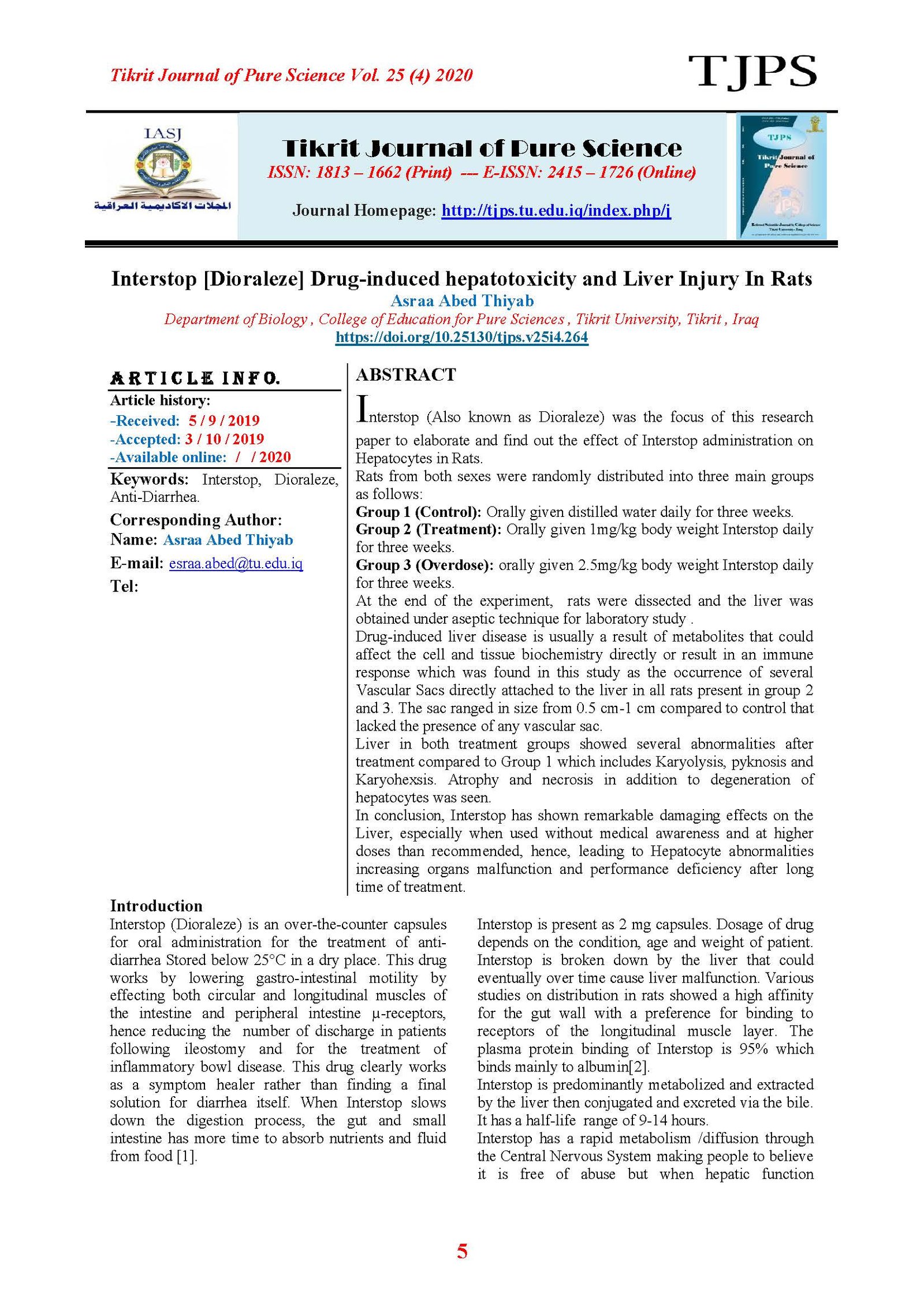Interstop [Dioraleze] Drug-induced hepatotoxicity and Liver Injury In Rats
Main Article Content
Abstract
Interstop (Also known as Dioraleze) was the focus of this research paper to elaborate and find out the effect of Interstop administration on Hepatocytes in Rats.
Rats from both sexes were randomly distributed into three main groups as follows:
Group 1 (Control): Orally given distilled water daily for three weeks.
Group 2 (Treatment): Orally given 1mg/kg body weight Interstop daily for three weeks.
Group 3 (Overdose): orally given 2.5mg/kg body weight Interstop daily for three weeks.
At the end of the experiment, rats were dissected and the liver was obtained under aseptic technique for laboratory study.
Drug-induced liver disease is usually a result of metabolites that could affect the cell and tissue biochemistry directly or result in an immune response which was found in this study as the occurrence of several Vascular Sacs directly attached to the liver in all rats present in group 2 and 3. The sac ranged in size from 0.5 cm-1 cm compared to control that lacked the presence of any vascular sac.
Liver in both treatment groups showed several abnormalities after treatment compared to Group 1 which includes Karyolysis, pyknosis and Karyohexsis. Atrophy and necrosis in addition to degeneration of hepatocytes was seen.
In conclusion, Interstop has shown remarkable damaging effects on the Liver, especially when used without medical awareness and at higher doses than recommended, hence, leading to Hepatocyte abnormalities increasing organs malfunction and performance deficiency after long time of treatment.
Article Details

This work is licensed under a Creative Commons Attribution 4.0 International License.
Tikrit Journal of Pure Science is licensed under the Creative Commons Attribution 4.0 International License, which allows users to copy, create extracts, abstracts, and new works from the article, alter and revise the article, and make commercial use of the article (including reuse and/or resale of the article by commercial entities), provided the user gives appropriate credit (with a link to the formal publication through the relevant DOI), provides a link to the license, indicates if changes were made, and the licensor is not represented as endorsing the use made of the work. The authors hold the copyright for their published work on the Tikrit J. Pure Sci. website, while Tikrit J. Pure Sci. is responsible for appreciate citation of their work, which is released under CC-BY-4.0, enabling the unrestricted use, distribution, and reproduction of an article in any medium, provided that the original work is properly cited.
References
[1] Awouters F., Niemegeers CJ. Janssen PA. Pharmacology of antidiarrheal drugs. (1983). Annu. Rev. Pharmacol Toxicol. 23:279-301.
[2] Berger, S.I., Ma'ayan, A., Iyengar, R. Systems pharmacology of arrhythmias. (2010). Sci Signal.
[3] Use Dioraleze, Revised October 2016. Johnson & Johnson Consumer Inc. McNeil Consumer Healthcare Division Rx, USA U.S. Patent 3, 714,159 .
[4] C hugnet, JL Cadore, T Mathete, (1996). Imodium Poisoning in The Dog. Toxicology Veterinary Centre. France
[5] Mackerer CR, Brougham LR, East PF. (1977). Antidiarrheal and central nervous system activities of SC-27166 (2-(3-5 - methyl -1,3,4- oxadiazol -2 –yl) - 3, 3 – diphenylpropyl) - 2 -azabicyclo (2.2.2)octane), a new antidiarrheal agent, resulting from binding to opiate receptor sites of brain and myenteric plexus. J Pharmacol Exp Ther. 203(3):527-38.
[6] Julia H, Evbu O, Irbaz Bin Riaz, Fashad M., Yuval Raz, (2015). The Long Q Teaser: Loperamide Abuse. University of Arizona. The American Journal of Medicine. USA.
[7] Imodium Hydrochloride Tablets USP 2 mg Oral Antidiarrheal Agent, Apotex Inc. January 6, 2012. Weston, Ontario.
[8] Riviere J., Papich M., Adams H., (2011). Veterinary Pharmacology and Therapeutics. [9th ed.] WILEY-BLACK WELL, A John Wiley& Sons, Inc., Publication. USA.
